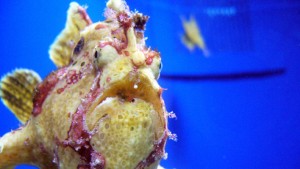A novice hobbyist once asked me whether there’s a particular “rule of thumb” with respect to the size of fish that can be kept in the same tank with a predatory fish, such as a lionfish or grouper. He’d heard somewhere that the other fish would need to be at least half the size of the predator, and he wanted to know if I could confirm this.
I replied that there really isn’t any such rule that applies in all circumstances because predatory fish vary considerably in the size of prey they’ll attempt to consume as well as the “tools” they have at their disposal for dispatching them.
Here are some factors that must be considered before pairing any predatory fish with a piscine tankmate:
Are fish on the predator’s menu?
Not all predatory fish include other fish in their natural diet. For example, many species that we keep in aquariums are zooplanktivores and are a threat only to the tiniest prey items—certainly not to other fish sharing their tank (unless you’ve got fish larvae in there, which is highly unlikely in a typical community tank).
Others, such as the popular snowflake moray eel (Echidna nebulosa), feed primarily on crustaceans and are usually safe to keep with other fish in aquariums (though there are reported exceptions, so I’d still be wary of keeping bite-sized tankmates with this species). Of course, when keeping crustacean-crunchers, shrimps, hermits, and other ornamental crustaceans are definitely in jeopardy of becoming meals.
Mouth-to-body ratio
One reason the half-as-big rule doesn’t work is that no two predatory species are exactly the same when it comes to the size of their mouths relative to their body length. Therefore, “too big to swallow” is a highly subjective term. For example, several of the Antennarius spp. frogfishes reach only about 4 to 5 inches in length but have remarkably capacious mouths, allowing them to engulf fishes almost as large as themselves.
At the other end of the spectrum are larger predatory fish with relatively small mouths. Take the popular moon wrasse (Thalassoma lunare) for example. It commonly reaches a respectable 10 inches in length but has a rather diminutive mouth by comparison, making it a predatory threat only to fish much smaller than itself.
Type of dentition
With some predators, the body size of potential prey items isn’t especially significant because they have the dentition to reduce tankmates into bite-size pieces. In the case of some such species, fish aren’t even typically counted among their natural prey items, but they may, nonetheless, consume smaller fish sharing their aquarium or “sample” larger tankmates by biting chunks out of them. The more aggressive triggerfishes (e.g., Balistapus undulatus) and certain puffers (e.g., Diodon holocanthus) come to mind here.
Have you done your homework?
Short of asking fish to “open up and say ahhh” so you can measure their mouths and examine their teeth, how can you determine which fish might prey upon others and which might get eaten? This is just one more example of where it pays to do a little research on the fish you’re interested in buying.
Before laying down your hard-earned cash for a specimen, check out the various species profiles here at Saltwater Smarts and in other reliable sources. For example, you’ll find a myriad of excellent species accounts at LiveAquaria.com. Also, if you have a copy of Scott Michael’s Marine Fishes: 500+ Essential-to-Know Aquarium Species (TFH Publications, 2001), I would recommend taking it right along with you to your LFS when you go shopping for specimens.



